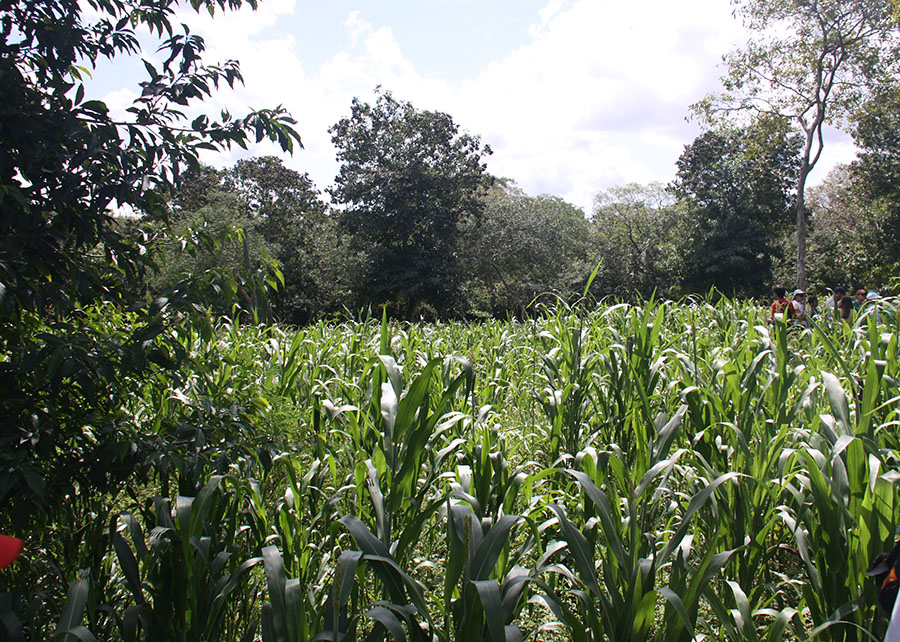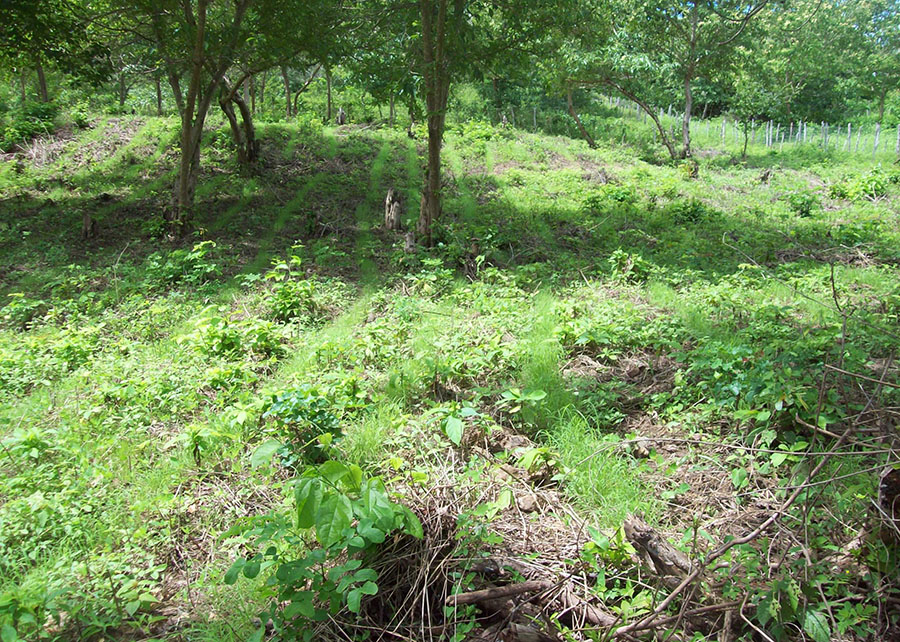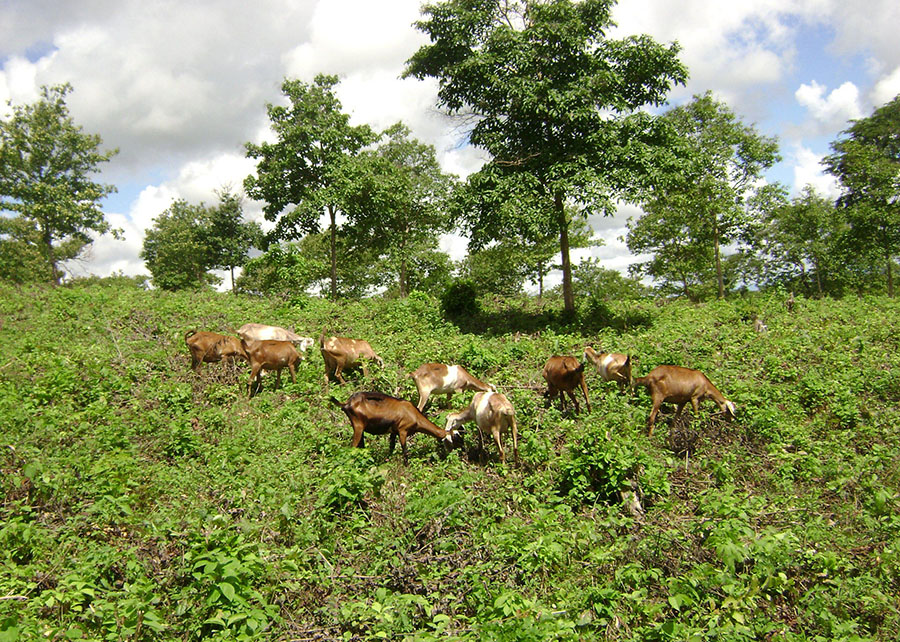Agroforestry systems provide soil carbon stocks that are 30% higher than natural vegetation
Agroforestry systems provide soil carbon stocks that are 30% higher than natural vegetation
Photo: Teógenes Senna de Oliveira

Land use changes can cause higher rates of soil carbon, according to IPCC. Agroforestry systems are sustainable alternatives
|
The adoption of conservation management practices in the Caatinga biome, such as agroforestry systems, not only preserves the soil carbon stock, but also increases it in long term compared to natural vegetation, contributing to the mitigation of greenhouse gas emissions. That is the main conclusion of a study carried out by Embrapa Goats and Sheep, whose results were published by the Journal of Environmental Management, by Elsevier. The results indicate that agroforestry systems increase the soil carbon stock in up to 30.9% when using crop rotation system, compared to natural vegetation.
The study lasted 25 years and was carried out in the municipality of Sobral, in Ceará state, located in the Brazilian Semiarid region. The software Century was used in the study to simulate and compare the soil organic matter dynamics in agricultural practices traditionally used in the region – shifting cultivation and slash-and-burn system – with agroforestry systems, observing different fallow periods: 0, 7, 15, 30, 50, and 100 years.
 “In the Caatinga biome, the slash-and-burn system without fallow periods reduces in 50% the soil carbon stocks in the first 10 years of cultivation, and the recovery initial level is only possible after 50 years of fallow”, the biologist Anaclaudia Alves Primo, doctor in Ecology and Natural Resources, informs. She conducted the study at Embrapa. According to her, agroforestry systems are sustainable alternatives to recover and increase the soil carbon stocks faster and without demanding long fallow periods. “Crop rotation of different agroforestry systems seems to be a good alternative to provide higher soil carbon sequestration”, she affirms.
“In the Caatinga biome, the slash-and-burn system without fallow periods reduces in 50% the soil carbon stocks in the first 10 years of cultivation, and the recovery initial level is only possible after 50 years of fallow”, the biologist Anaclaudia Alves Primo, doctor in Ecology and Natural Resources, informs. She conducted the study at Embrapa. According to her, agroforestry systems are sustainable alternatives to recover and increase the soil carbon stocks faster and without demanding long fallow periods. “Crop rotation of different agroforestry systems seems to be a good alternative to provide higher soil carbon sequestration”, she affirms.
In the Semiarid region, most farmers manage land in an intensive system, using slash-and-burn methods to grow crops like corn and beans. After two years, the area is either left fallow or is used for livestock, which may accelerate desertification processes. Then, the farmers look for another area to be explored the same way.
According to reports by the Painel Intergovernmental Panel on Climate Change (IPCC), changes in land use can promote the storage of higher quantities of soil carbon, which justifies studies on different management systems and on how they affect this dynamic.
Vital componentCarbon is a vital soil component because it plays an essential role in the functioning of terrestrial ecosystems. It is available in the atmosphere as carbon dioxide (CO2), one of the main gases emitted during anthropogenic actions (activities produced or caused by humans), which increase greenhouse effect and global warming. “That is why it is important that carbon remains in the soil”, Anaclaudia Primo explains. If the slash-and-burn method is used, all carbon that forms the vegetation and the one stocked in the soil are emitted as CO2. However, when there are alternative practices like agroforestry systems, in which the vegetation is neither deforested nor fire is applied, or when there are fallow periods between crops, carbon is preserved. “Thus studies related to the adoption of management practices aimed at soil carbon conservation and preservation contribute to the mitigation of global climate change”, she assures. |
MethodologyThe research used the Century simulation model to predict and compare the temporal dynamics of soil organic carbon in a traditional management system of slash and burn against different types of agroforestry systems in the Semiarid region, until 2100. The study was carried out on Fazenda Crioula, a farm that belongs to Embrapa Goats & Sheep, and used data collected in an experiment that started in 1997 and originally studied three models of systems. The first studied system was traditional management, which uses the slash-and-burn method to deforest the natural vegetation and grow annual crops for two years, after which the area will be left and farmers will adopt the same practices in another plot of land. Agrosilvopastoral was the second studied system, in which corn and sorghum are sown in rows between leucaena and gliricidia. Despite not being originally from the Caatinga vegetation, these tree species adapted to the region and can be used to feed the animals included in the model. Silvopastoral was the third system, which consists of a model in which Caatinga areas are thinned and lowered to be used for goat and sheep grazing. Finally, an unmanaged area of Caatinga natural vegetation was used as reference. Primo explains that, to adopt the Century model, they resorted to files that had been calibrated for Caatinga vegetation and made available by researchers from the Federal University of Pernambuco (UFPE). Then, data of the experiment region were inserted, which corresponds to the model parameterization step. “After that, we prepared the input file: one containing soil (texture, density, pH) and weather (precipitation, maximum and minimum temperature) data; and the other with different types of management (traditional intensive farming, traditional burn-and-slash model with different fallow periods, and fixed and rotarional agroforestry). After inserting the files, we ran each scenario separately to observe the carbon stock reaction in each different type of management for 100 years. After each scenario simulation, we compared the information simulated by the Century model with the data obtained on farm.” Photo by: Ana Elisa Sidrim |
Main results
The research simulated scenarios for agroforestry systems with two types of management: continuous and rotation (crops alternating among agrosilvopastoral, silvopastoral, and natural vegetation); it also simulated scenarios for the burn-and-slash area, with different fallow periods, predicting the next 100 years. The results show that, in the burn-and-slash system, the carbon losses diminished from 74.7% (management without fallow periods) to 28.7% in 7 years of fallow after cultivation.
Therefore, in the burn-and-slash scenario, the longer the fallow periods are, the higher the soil carbon stock is; however, only after a 30-year fallow period, the percentage is the same of the natural vegetation, and after a 50-year fallow the carbon stock increases in 4% if compared to balanced natural vegetation. According to the study, a 20-year fallow period, as suggested by IPCC as the necessary time for carbon stock recovery after any change in land use, is not enough to recover the soil carbon stocks in the Brazilian Semiarid region.
In the agroforestry systems, simulations were carried out for both continuous and rotation management, comparing them to balanced natural vegetation and burn-and-slash system with a 7-year fallow period. The results indicates that the carbon stocks in agroforestry systems increased in up to 18.6% in continuous management and 30.9% in rotation management, compared to the natural vegetation. “When we compare only continuous and rotation managements of agroforestry systems, even having equal initial carbon stock values, as time goes by, rotation system presented higher values (10.5%) compared to continuous system”, Anaclaudia Primo says.
In agrosilvopastoral management, there is carbon removal during corn or bean harvesting; however, this removal is compensated by adding animal manure and cropped plant rests, besides the permanent vegetation and litter (layer of dried leaves, branches, fruit rests, and dead flowers and animals on soil surface). Uprooting 60% of the system trees increases luminosity and favors the development of the closer to the soil vegetation and litter accumulation, which helps increasing the soil carbon percentage.
 “Agroforestry systems can be used as carbon sinks (places that absorb more CO₂ that they release) in semiarid regions that present advanced levels of environmental degradation caused by human action”, Anaclaudia Primo explains. She also affirms that the social development in the region is affected by environmental degradation because it impairs food production and power generation, leaving local populations in a vulnerable situation.
“Agroforestry systems can be used as carbon sinks (places that absorb more CO₂ that they release) in semiarid regions that present advanced levels of environmental degradation caused by human action”, Anaclaudia Primo explains. She also affirms that the social development in the region is affected by environmental degradation because it impairs food production and power generation, leaving local populations in a vulnerable situation.
Éden Fernandes a zootechnician at Embrapa Goats & Sheep, believes that the results of this study are useful for farmers who work in the Semiarid region, since it represents a sustainable and permanent land use that can substitute the constant moving to other areas to grow crops or livestock.
Fernandes emphasizes that another advantage to those who adopt agroforestry systems in the region is that their farms will not require long fallow periods. “This is, those who already adopt these systems know the land requirements to keep producing in the future, besides contributing to diminish the effects of global warming”, he concludes.
Adriana Brandão (MTb 01.067/CE)
Embrapa Goats and Sheep
Press inquiries
caprinos-e-ovinos.imprensa@embrapa.br
Phone number: +55 88 3112-7544
Translation: Ana Maranhão
Superintendency of Communications
Further information on the topic
Citizen Attention Service (SAC)
www.embrapa.br/contact-us/sac/

